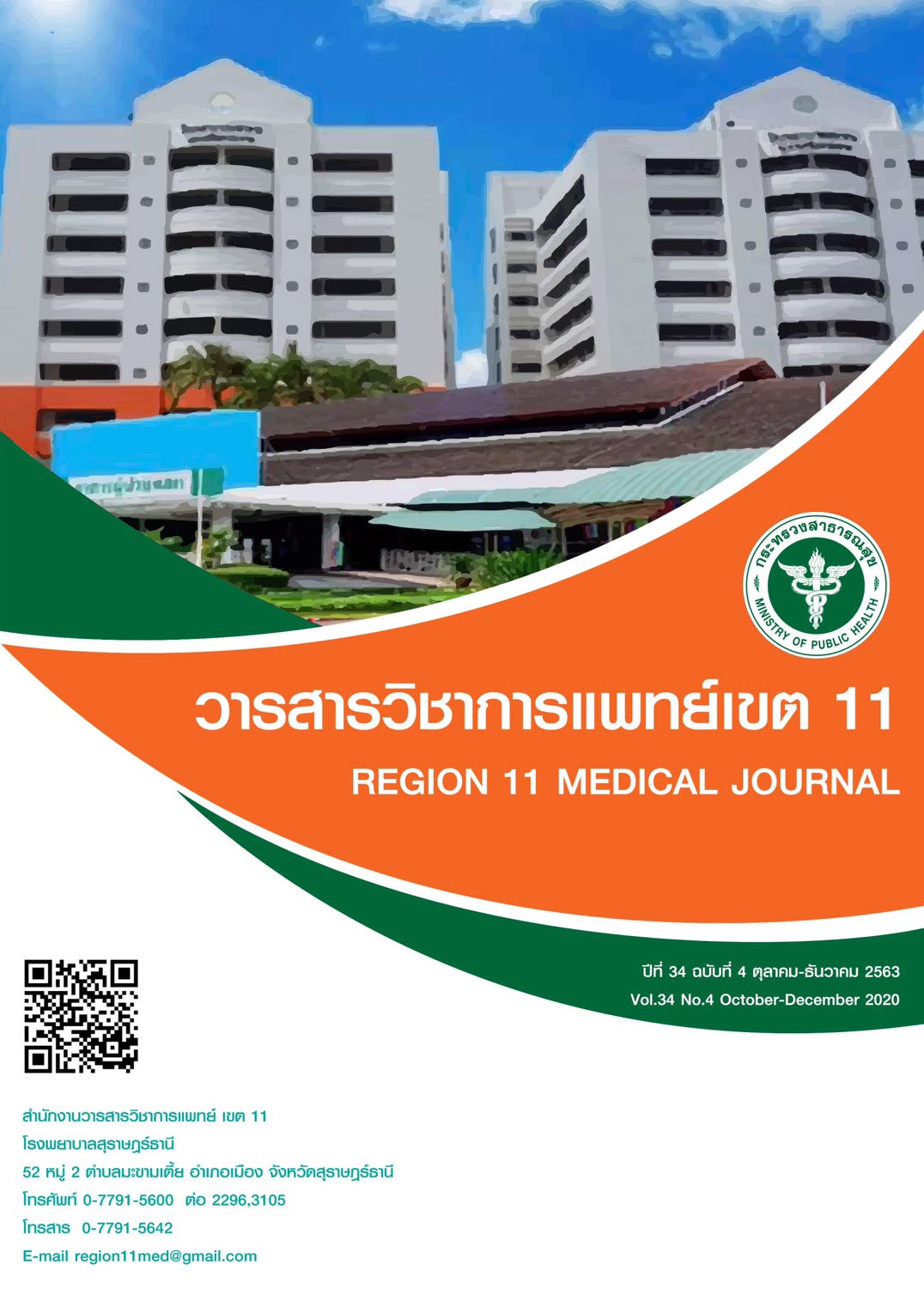The development of care model for continuous ambulatory peritoneal dialysis patients by using the primary nursing system in Suratthani Hospital
Keywords:
continuous ambulatory peritoneal dialysis, primary nursing system, care modelAbstract
Background: The process of caring for patients with chronic kidney disease lacked continuity and lacked communication with nurses in ward. The occurrence of complications after discharge of patients for continuous ambulatory peritoneal dialysis (CAPD) at home.
Objectives: 1) To develop a model of care for patients undergoing CAPD 2) To examine the effectiveness of used the primary nursing system.
Methods: There were 4 phases: 1) situational analysis 2) CAPD Model development 3) Implementation and 4) Evaluation. Participants were 31 registered nurses, 120 CAPD patients undergoing CAPD for at least 6 months. The instruments consisted of 1) Infection record form 2) Interview form for multidisciplinary team 3) Interview form for patients and caregivers 4) test knowledge of nurses 5) patients self-care ability questionnaire 6) satisfaction of nurses’ questionnaire and 7) The 9 Thai quality of life. The instruments were examined for contents validity by the five experts. The validity were 0.77, 0.82, 0.84, 0.83 and the reliability were 0.84, 0.90, 0.85, 0.85, 0.79 respectively. The data were analyzed using descriptive statistics, dependent t-test and Chi-square test.
Results: Results found that 1) a care model for CAPD patients using the primary nursing system significantly enhanced nurses' knowledge at a good level (mean=18.03, SD=1.22) (p<0.01). Nurses' satisfaction and Patients' satisfaction were at a good level (mean =3.93; SD=.57) and (mean=4.43; SD=.82); respectively. Selfcare ability of CAPD patients were increasing (p<0.01). The rate of peritonitis and sites of CAPD infection were decreased significant (p<0.01) 6) CAPD patient quality of life was a good level (p<0.01).
Conclusion: A care model for CAPD patients using the primary nursing system can be care CAPD patients and can be development to chronic care disease.
References
Jha.V.,&Model, G.K.Getting to know the enemy better.Rhe global burden of chronic kidney disease.Kidney international.94(3), 2018;462-464.
US Renal Data System 2019 Annual Data Report: Epidemiology of Kidney Disease in the United States.[cited 2019 Dec 4]. Available from:https://www.usrds. org/media/2371/2019-executive-summary. 2019.
กระทรวงสาธารณสุข. ข้อมูลเพื่อตอบสนอง Service Plan สาขาไต 2562. สืบค้นเมื่อ 5 ตุลาคม 2562,จากhttps://hdcservice.moph.go.th/hdc/reports/page.php?cat id=e71a73a771474e63b71bccf727009ce.
National Health Security Office. Report on the implementation of the abdomen rehabilitation project in the universal health care program. [cited 2019 Dec 14]. Available from: http: //www.kdf.nhso.go.th/. Thai.
สำนักงานหลักประกันสุขภาพแห่งชาติ. สำนักงานกองทุนการสร้างเสริมสุขภาพ CAPD report 2019.Bangkok:NHSO. สืบค้นเมื่อ 7 ตุลาคม 2562 จากแหล่งข้อมูล http://www.kdf.nhso.go.th.
นพมาศ ขำสมบัติ และ กัญญดา ประจุศิลป์. ผลของการใช้รูปแบบการพยาบาลเจ้าของไข้ของผู้ป่วยไตวายเรื้อรังต่อภาวะน้ำเกินและความพึงพอใจในบริการพยาบาลวารสารพยาบาลทหารบกปีที่ 15 ฉบับที่ 2 (พ.ค. - ส.ค.), 2557;405-413.
Marram,G.etal. Primary nursing: A model for individualized care. St.Louis: C. V.Mosby.1979.
Orem, D. E., Taylor, S. G., & Renpenning, K. M. Nursing: Concepts of practice (6th ed.). St. Louis: Mosby. Pichayapinyo, 2001; 2013.
พารุณีวงษ์ศรีและทีปทัศน์ ชินตาปัญญากุล. การประยุกต์ใช้ทฤษฎีของโอเร็มกับการดูแลและการให้คำแนะนำผู้ป่วยที่มีภาวะหัวใจล้มเหลว วารสารพยาบาลตำรวจ ปีที่ 10 ฉบับที่ 1 มกราคม – มิถุนายน 2561; 209-219.
นุช โพธิ์ศรีวิไล.ผลลัพธ์ของการใช้แนวปฏิบัติการพยาบาลทางคลินิกในการดูแลผู้ป่วยโรคไตเรื้อรังระยะสุดท้ายที่บ้านซึ่งได้รับการรักษาด้วยวิธีการล้างไตทางช่องท้องชนิดต่อเนื่อง.วิทยานิพนธ์พยาบาลศาสตรมหาบัณฑิตสาขาวิชาการพยาบาลเวชปฏิบัติชุมชนบัณฑิตวิทยาลัย มหาวิทยาลัยคริสเตียนม, กรุงเทพมหานคร, 2557.
Mac Guire, J. An approach to evaluating the introduction of primary nursing in an acute medical unit for the elderly: Principles and practice. International Journal Nursing Study, 26,1989 ; 243-251.
Charyton, D., Kuntz, R. E., Mauri, L., and DeFilippi, C. Distribution of coronary artery disease and relation to mortality in asymptomatic hemodialysis patients. American Journal of Kidney Disease 49(3): 2007; 409-416.
Fisher,w.,Fisher,J.D.,and Harman,J.The Information-Motivation-Behavioral Skills Model:A generalsocial psycological approach to understanding and promoting health behavior:Suls,J.,Wallston,A.K.,editors,Social Psychological foundations of health and illness,82-100.Malden:Blackwell.2003.
Ryan,P., & Sawin, K. J. The Individual and Family Self-management Theory: Background and perspectives on context, process, andoutcomes. Nursing Outlook, 57(4),2009 p 217-225. Retrieved April 24,2017, from https://www.ncbi.nlm.nih.gov /pmc/articles/PMC2908991/.
Aechibong, U. E. Evaluation impact of primary nursing practice on the quality of nursing care. Journal of Advance Nursing 29(3): 1999; 680-689.






